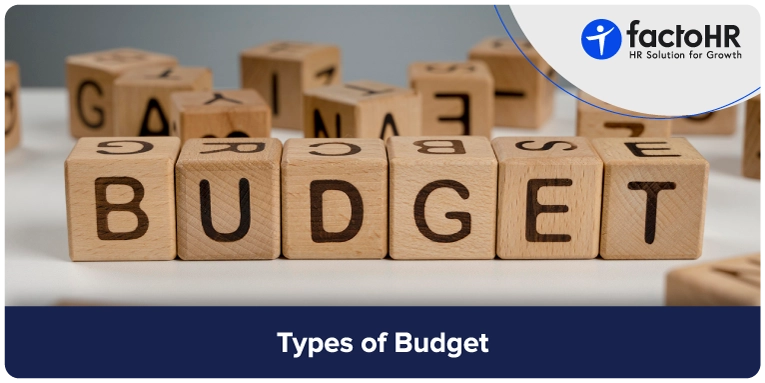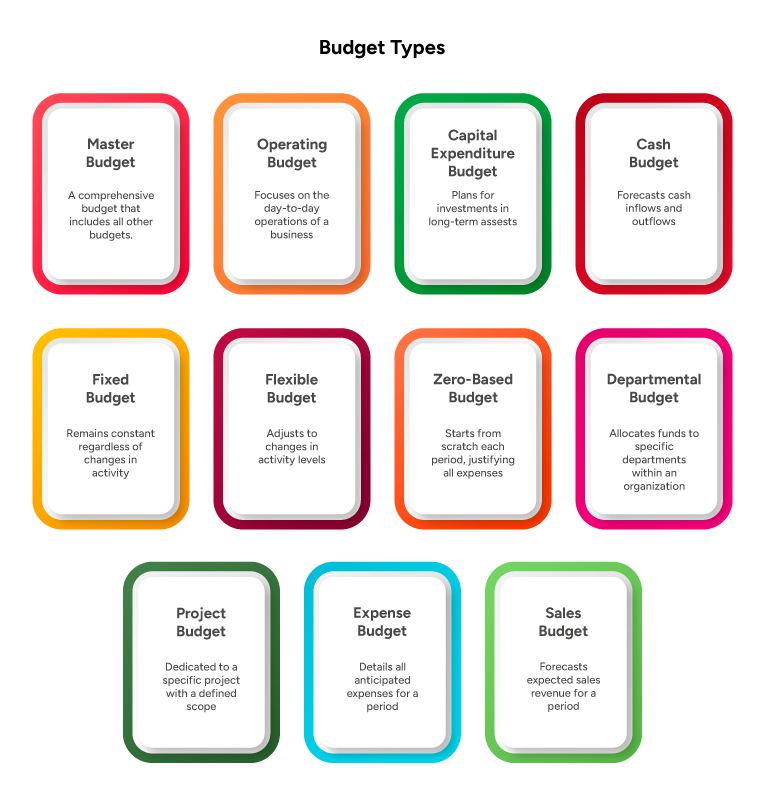What is a Budget? Meaning, Benefits, Types & How to Create

Table of Contents
Key Highlights
- A budget helps the organization manage resources wisely and make better financial decisions.
- Different types of budgets give structure to personal and business planning.
- Budgeting supports financial stability by preparing for present needs and future goals.
- A clear financial plan is the key to tracking income, expenses, and resources over time.
- Understanding various budget types improves long-term financial growth and security.
What is a Budget?
The meaning of budget is a detailed financial plan that outlines expected income, projected expenses, and the allocation of resources over a defined period.
The budget provides a structured framework for managing financial resources, which includes various HR activities. Some of these include employee salaries, training and development programs, recruitment expenses, benefits, and other critical HR functions.
Benefits of Budgeting
Explore some of the major benefits of a well-planned budget for an organization.
- Budgeting helps the organization track income and expenses so you can manage money more effectively.
- It helps prevent overspending by illustrating how resources are allocated and identifying areas where costs can be reduced.
- A clear financial plan helps companies set and prioritize financial goals like savings, debt repayment, and investments.
- It supports better decision-making by giving a clear picture of the financial situation.
- Budgeting helps build an emergency fund for unexpected expenses or financial stress.
- It improves financial discipline and helps stay committed to long-term financial commitments.

Types of Budget
Organizational budgets vary by purpose, scope, and frequency of preparation. There are several types of budgets, such as:

Master Budget
A master fund is a complete financial plan that combines all individual budgets of a company, such as sales, production, and cash budgets. It gives a clear overall view of expected income and expenses and helps the organization plan, control, and achieve its financial goals.
Operating Budget
An operating financial plan outlines a company’s expected income and expenses for daily operations within a specific period. It includes projected sales, production costs, and operating expenses. An operating budget helps the organization plan its activities, control spending, and ensure smooth business operations throughout the year.
Capital Expenditure Budget
A capital expenditure fund outlines the planned spending on long-term assets such as machinery, equipment, and buildings. In situations where determining which major investments are necessary for growth is challenging.
This financial plan provides the clarity needed to make informed decisions. You will be able to estimate costs, expected returns, and the financial impact of future projects.
Cash Budget
It shows inflows and outflows over a set period. It helps an organization plan its cash, avoid shortages, and run daily activities smoothly. It also highlights cash flow issues early so managers can take timely and informed decisions.
Fixed Budget
A fixed fund is a plan in which the revenue and expense amounts remain the same throughout the period. It does not change even if activity levels rise or fall. This provides stability and helps organizations control costs with clear spending limits.
Flexible Budget
A flexible financial plan changes its income and expense estimates based on actual activity. The aim is to help organizations adjust to market changes when production or sales increase or decrease. This gives managers better control over changing business conditions.
Zero-Based Budget
A zero-based financial plan requires every expense to be justified from the beginning for each period. Every cost must be approved and connected to a clear purpose. This method removes wasteful spending and ensures money is used only for necessary activities.
Departmental Budget
A departmental fund refers to the funds allocated to a specific team or department within an organization. It covers that department’s expenses and expected income. It serves as a key tool to strategic planning, enabling better control of resource utilization and supporting the achievement of team objectives.
Project Budget
A project plan lists all the estimated costs required to complete a particular project. This includes costs for materials, labor, and other project requirements. Managers can track expenses and avoid overspending with ease.
Expense Budget
This budget shows the planned expenditure of an organization for a given period. It includes costs like salaries, utilities, supplies, and maintenance. This acts as a reference to keep the organization within its financial limits.
Sales Budget
It predicts future revenue using past sales, market demand, and industry trends. Every organization is dependent on this type of fund to decide sales targets, plan production, and guide major financial decisions.
Various types of budgets are used in organizations. However, the specific plan may differ based on the organization’s size, industry, and goals.

Key Reasons why a Budget is Important
There are five core reasons that show the importance of budget for both large enterprises and small startups.
Financial Control
It helps you understand your income and operational expenditure. It gives better financial control and helps avoid unwanted expenses.
Emergency Readiness
A fund helps save for emergencies. These savings support during difficult times without disturbing recurring monthly expenses.
Better Cash Flow Management
It assists in planning the timing of funds and scheduled expenditures. This makes it easier to pay bills on time and stay organized.
Review Budget Performance
This can help in monitoring the financial progress regularly. You can see what is going well, what needs improvement, and make changes to stay on track with performance management software.
Stronger Team Accountability
In companies, it sets clear spending limits for each team. It helps everyone use company money responsibly and prevents overspending.
How to Create a Budget Plan
If companies want to plan their income and expenses clearly for better financial management, here is a quick step-by-step guide.
Step 1: Set Your Financial Goals
Set clear targets and choose simple measures to track progress. Form a small team to handle the budgeting work.
Step 2: Gather Financial Data
Collect past financial records like income, expenses, and cash flow. Check patterns to understand the current financial position and identify your limits and opportunities.
Step 3: Identify Your Income Sources
List all ways an organization can generate revenue, such as sales, grants, or donations. Estimate future income based on market conditions, like inflation and seasonal demand.
Step 4: Estimate Expenses
List all fixed, variable, and semi-variable expenses. Use records or industry averages to estimate future spending.
Step 5: Create a Budget Structure
Organize all income and expense items in a simple format. Make the financial plan easy to read and understand to ensure every cost is justified clearly.
Step 6: Review and Revise
Check the financial plan with the team to confirm it matches goals. Correct any errors or missing details and get approval from senior leaders before finalizing.
Step 7: Put the Budget into Action
Share the plan with all departments and track actual income and expenses regularly. Make sure teams follow the budgetary constraints.
Step 8: Monitor and Adjust
Compare actual results with the fund often. Update the plan when market conditions or goals change. Use mid-year reviews to keep the financial plan relevant.
Step 9: Evaluate Results and Improve
Review the full budgeting process at the end of the year. Identify areas that perform well and those that require improvement.

Best Budgeting Tools for Corporate Use
Budgeting tools have pre-coded functionalities to help plan cash flow, control costs, and get a clear view of your finances. Explore some of the best tools for leaders to track spending and make quick decisions.
ERP Systems
ERP (Enterprise Resource Planning) systems combine budgeting with other finance functions in a single system. This provides a unified view of company income, expenses, and cash to plan better.
Financial Planning Software
These tools help create detailed budgets, forecasts, and “what if” scenarios. You can count on them to see how changes in sales, costs, or plans can affect your business. To manage travel expenses more easily, companies can use tools like travel and expense management software.
Spreadsheets
Spreadsheets like Excel or Google Sheets are simple and flexible. They suit small teams that want basic budgeting, quick edits, and easy sharing.
Cloud-Based Budgeting Tools
Cloud tools allow teams to work on the same budget from anywhere. Data updates in real time, so everyone sees the latest numbers and avoids confusion.
AI-Driven Tools
AI budgeting tools use data to predict trends and future results. They help companies identify risks early and plan more confidently using insights, not guesswork.
Conclusion
Understanding the different types of budgets helps organizations manage their revenues better and achieve financial goals. Budgeting is a continuous process; therefore, it is advisable to review it regularly and update it when needed.
Businesses can simplify their human resource management by integrating effective budgeting strategies to drive organizational success.

Frequently Asked Questions
What are the Five Stages of the Budgeting Process?
The five stages are setting goals, collecting financial data, preparing the budget, implementing it, and reviewing the results. These steps help keep the budget practical and useful.
What are the Common Challenges to Avoid in Budgeting?
Incorrect data, unclear goals, and a lack of periodic review are three common challenges in every budget. Avoiding these helps you maintain a simple and effective budget.
What are the Three Main Types of Budget?
The three main types are operating budgets, capital budgets, and cash budgets. Each one supports different financial planning needs.
How does Budgeting Help a Company Grow and Expand?
Budgeting helps companies plan spending, manage costs, and use money wisely. This supports better decisions and long-term business growth.
Why do Organizations Need to Revise Their Budgets from Time to Time?
Budgets must be updated when market conditions or expenses change. Regular revisions keep the financial plan accurate.
What is Budget Management?
Budget management means planning, tracking, and controlling income and expenses. It ensures funds are used appropriately and supports financial stability.
What is Budget Forecasting and Planning?
Budget forecasting predicts future income and expenses. On the other hand, budget planning helps set clear limits and goals, which allows organizations to prepare for financial changes and make better decisions.
Grow your business with factoHR today
Focus on the significant decision-making tasks, transfer all your common repetitive HR tasks to factoHR and see the things falling into their place.

© 2025 Copyright factoHR


